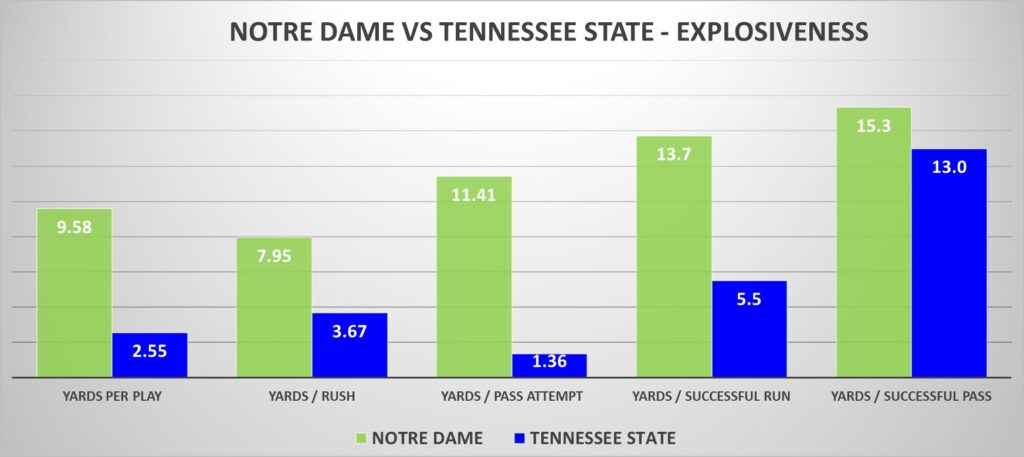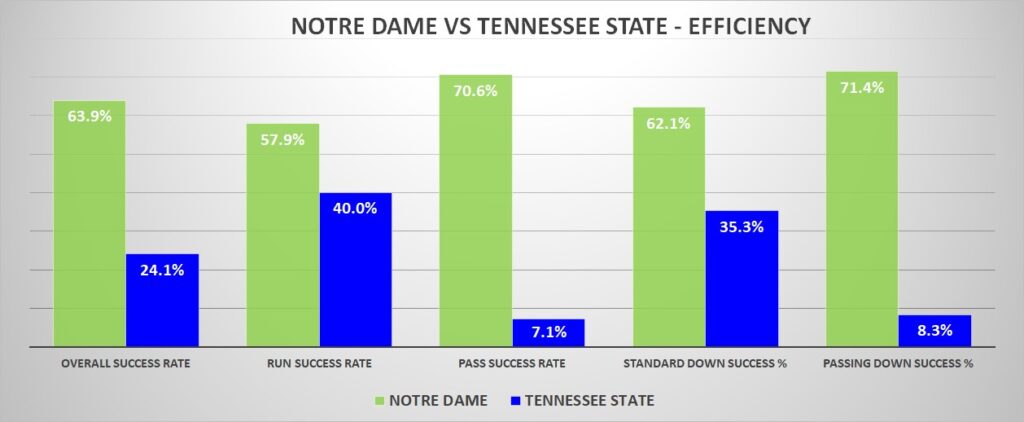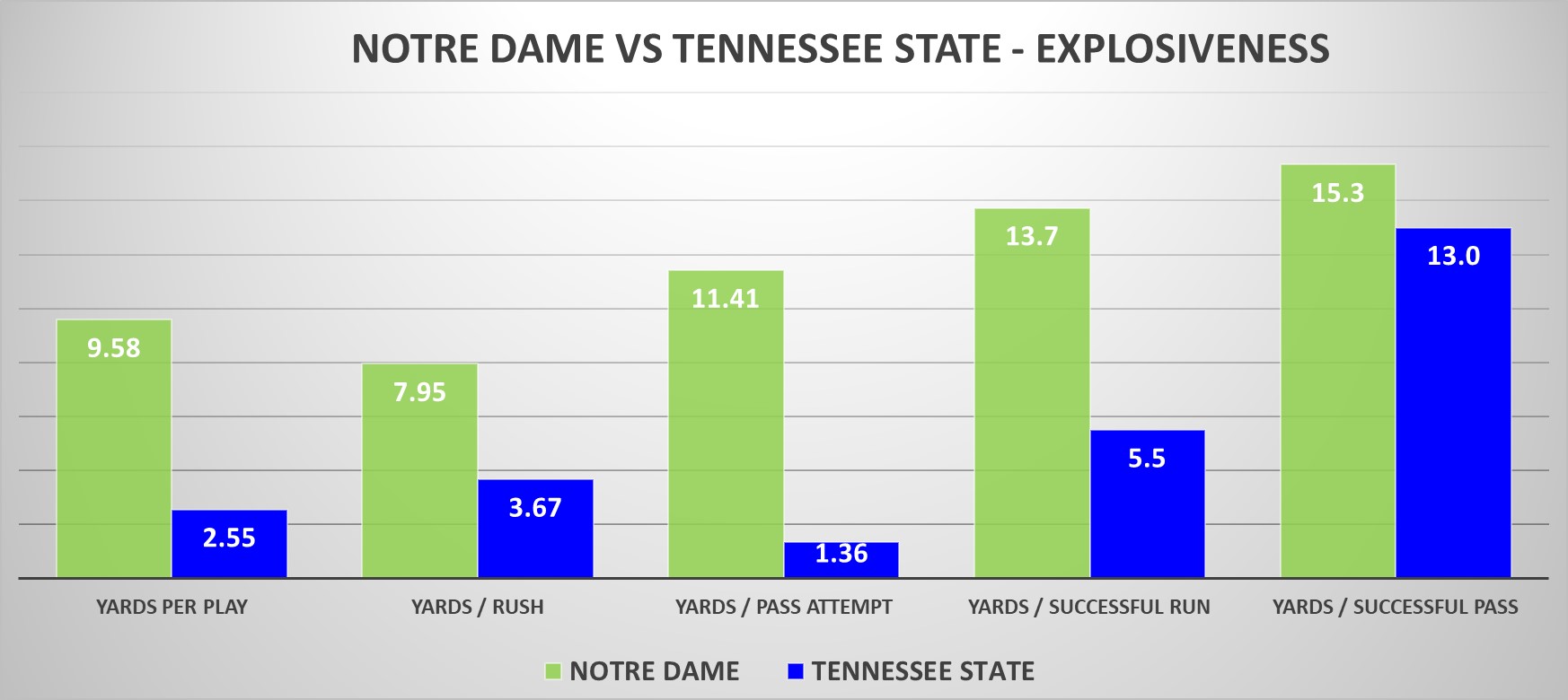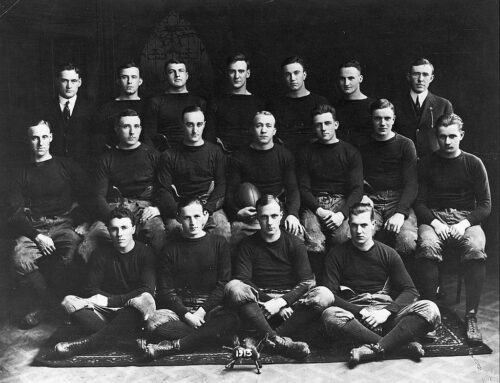Notre Dame dominated Tennessee State as expected, with a a huge second quarter propelling Notre Dame to a game that reached garbage time by halftime. The Irish continued the early trend started in Dublin – crisp execution, nothing too flashy, but methodical drives for touchdowns on offense and clamping down defensively at the first signs of opponents veering off schedule.
Garbage time starts at halftime for most stats below (exceptions: scoring opportunities data, havoc rates) with Notre Dame carrying a 35-3 lead at intermission. So for the main analysis (explosiveness, efficiency, etc.) a whopping 45% of plays are thrown out.
Stats from a few excellent sources – College Football Data, Game On Paper, and often referencing SP+ and FEI numbers. If you get lost, check out this handy advanced stats glossary here or reach out in the comments.
Computers give credit for dominance, even vs. FCS

It’s funny in retrospect this game felt irritating for a few minutes – a sleepy first drive for the Irish defense combined with some questionable officiating with the Devyn Ford kickoff return fumble spotted Tennessee State two early scoring changes. From that point the Irish essentially put the game away in the second quarter, outpacing the Tigers 11.3 yards per play (YPP) to 2.0 and putting the game into garbage time by halftime. Notably even the second and third stringers for ND did their jobs, as the YPP gap in garbage time was still a very healthy +5 (ND 7.85, TSU 2.85).
This wasn’t a blue blood program flexing to prove a point (hello Oklahoma and Oregon), it was Marcus Freeman and company looking to gain valuable reps for developing young talent. And the early dominance still earns credit in the eyes of advanced stat systems and Vegas, especially for the latter when it’s paired with a strong passing of the eye test. Bill Connelly’s weekly SP+ rankings touched on this theme:
I’ve been running SP+ for a while, and one of the most common early-season plotlines goes like this:
1. Team obliterates a bad opponent by far more than projected (and by far more than what most teams would do).
2. SP+ reacts by bumping said team up significantly.
3. Everyone on social media screams “BUT THEY AIN’T PLAYED NOBODY.”
Treating a bad team like it’s a high school team has far more predictive power than we might instinctively think. It isn’t always a sign of greatness by any means, but it can be.
In my view SP+ tends to read too far into these inflation opportunities – especially when teams go unchallenged for long stretches, like Michigan teams of recent vintage (pre-playoff appearance teams that were exposed later in particular). But if this game is on the schedule, the best thing the Irish can do is win convincingly and reinforce the talent disparity that exists between the two teams. Check!
While all the appropriate caveats apply, in both games Notre Dame has controlled things in a very sustainable way. The Irish have created huge efficiency advantages and defensively avoided lapses leading to big plays (TSU had a long gain of 13 yards and just two 10+ yard gains before garbage time). While Sam Hartman hasn’t flashed the deep ball over the top yet (and hasn’t needed to), Audric Estime’s 50-yard run in this game was a new career-long, not to mention the explosive ability flashed by his RB room colleagues early (Jeremiyah Love) and late (Gi’Bran Payne and JD Price) as each collected a chunk play TD.
The Irish offense is an equal-opportunity machine so far
While Audric Estime is the clear RB1 and leads the Notre Dame offense in touches and yards by a significant margin, the production and scoring across the skill position players has been an incredibly even split.
- The target share for Irish receivers has been incredibly dispersed so far. Jayden Thomas leads the way with 8 targets (catching all 8), followed by Rico Flores (6), Jaden Greathouse / Tobias Merriweather / Mitchell Evans / Gi’Bran Payne / Chris Tyree (5 each). Receiver by committee is working so far.
- 16 Notre Dame players have already caught a pass. Last season, only 13 players had a reception across the 13 games (including bowl game).
- Each of the top six receivers (by yards) – Thomas, Greathouse, Evans, Tyree, Price, Colzie – are averaging 15 yards per reception or more.
It will be fascinating to see the snap counts and rotation heading into an intense atmosphere on the road in Raleigh – will the Irish continue to heavily rotate in the younger faces like Greathouse, Flores, Love, and Price? Or will we see the rotation tighten up and the starting wide receivers (Thomas / Merriweather / Tyree) take on a heavier workload? Are there some change-ups in store with personnel groupings or highlighting players like Holden Staes that have been relatively quiet in the passing game so far?
Notre Dame’s defensive warms up before a new level of challenge

The safe play is to take a “wait and see” approach with the Irish defense still – it’s hard to glean much from the unique challenge of defending Navy and this game against an overmatched Tennessee State team. Still, it was nice to see the Irish face a more traditional offense and see the secondary activated in pass coverage, with Benjamin Morrison getting on the board with his first PBU of the year and picks for Ramon Henderson and Clarence Lewis. The early hypothesis that this unit could be devastating on passing downs isn’t confirmed yet, but opponents are off to a 2/17 start with successful plays on these long downs (2nd and 8+, 3rd and 5+) against Al Golden’s defense.

If there’s a situation to monitor – based on early returns as well as last year’s issues – it’s the consistency and effectiveness of the run defense. ND hasn’t been gashed, but in both games has allowed opponents to run the ball at average efficiency levels. In a limited sample (17 plays) the Irish have allowed 5.1 yards per carry on opponent first down runs. That combined with a low stuff rate (14%) leaves room for improvement – you’d like to see the disruptiveness and opponent run efficiency both move further in the right direction as competition stiffens and especially against two solid running QBs the next two weeks.
On to NC State
If you need a warning about the dangers of going to Raleigh, please look up NC State’s recent home record where the Pack are 18-2 over teh last three seasons. While advanced stat systems have elevated Notre Dame after their early dominance, Vegas is far more skeptical, with the line for Saturday’s game looking to settling at somewhere just over a touchdown in favor of the visitors.
Week 2 Composite Ratings!
Seeing a clear top 3: Georgia, Ohio St, Bama
Clear #4: Michigan
Then a whole mess of teams from 5-13 that are only separated by 2.5 pts@ESPN_BillC@bcfremeau@beta_rank_fb@KFordRatings@CFBWinningEdge pic.twitter.com/sSCWnrwfFh— Nate Manzo (@cfbNate) September 6, 2023
The Irish offense will face an entirely new level of competition – you could argue that Tony Gibson’s defense is the 3rd toughest on the schedule after Ohio State and Clemson, with all-ACC performers at each level and a strong CB duo. Brennan Armstrong did not see an immediate rejuvenation in his first game reunited for OC Robert Anae in Storrs, but at the very least he’s a tough runner and scrambling threat to stress the ND defense. In my season preview I highlighted the shaky skill position talent and offensive line situation, which also didn’t look great against the Huskies.
But it’s easy to envision a sluggish start adapting to the first P5 opponent of the year, combined with a noon kick on the road. Look for NC State to try to ugly this game up – manufacturing long drives using Armstrong’s legs, milking clock, and taking some calculated gambles at key moments.
For the Irish defense, it’s a golden opportunity – Armstrong struggles under pressure, NC State has yielded a lot of sacks, and the secondary should be able to play aggressively. But will the run game but stout enough to force early passing downs? And the offense able to continue operating efficient to stake an early lead? It’s the first of several ACC tests that Irish should pass, but looms as the major opportunity for a slip-up before the massive September showdown hosting Ohio State.





Excited to see a more appropriate matchup finally.
Heres a thought for the sake of discussion: is estime the RB1? Outside of the fumble, hes definitely played great, great YPC, broken tackles all that, but does one of the other backs raise the ceiling more?
By no means do I think audric played himself out of the job, but damn, when love and price have the ball in their hands, it feels like a rocket ship about to blast off! Maybe I can just file this under “irish champagne problems” but just curious what others thought.
Also, I’m pretty stoked to see Chris tyree playing well. Early in the season last year he got the ball a lot more before audric and logan took over, and while he didnt pop off, he always gave great grit in reading blocks on inside runs. It’s always been frustrating as hell seeing him get tackled, but through 2 games, looks like WR is the place for him. Well done sir!
I think the other guys offer more home run potential – Jeremiyah Love has the sprinter speed and is sitting at 9.6 YPC at the moment – but Estime is still entrenched as RB1. Price and Love just don’t have a lot of reps, and while they might be able to make more out of perfectly blocked plays, you’re probably sacrificing a lot of yards after contact and Estime’s ability to make the most of each carry. Last season Audric was one of the 2-3 most efficient runners in the P5 despite not having much of a passing attack to help him out (Miyan Williams from OSU and Blake Corum at UM were the only other ones in his success rate range).
Best case for those guys is that they continue to force more touches and carve out a bigger role, whether that’s situational (two-minute with their receiving skills?) or possibly leaping Payne for whatever the closest thing is to RB2. But Gi’Bran has looked very good in his own right.
Remember when Cam McDaniel was our best RB?
Wow, I didn’t realize how efficient audric was nationally!
I totally rescind my thought, let that dude run!
The other thing I would add here is that Love, Payne, and probably Price have some work to do to catch up to Estime and Ford in blitz pickup. I think it was Payne in the first half two minute drill against Navy who almost got Hartman killed, and then Ford took over on that drive. Obviously blitz pickup isn’t the sexiest trait but it’s one that coaches care about a lot, and for good reason.